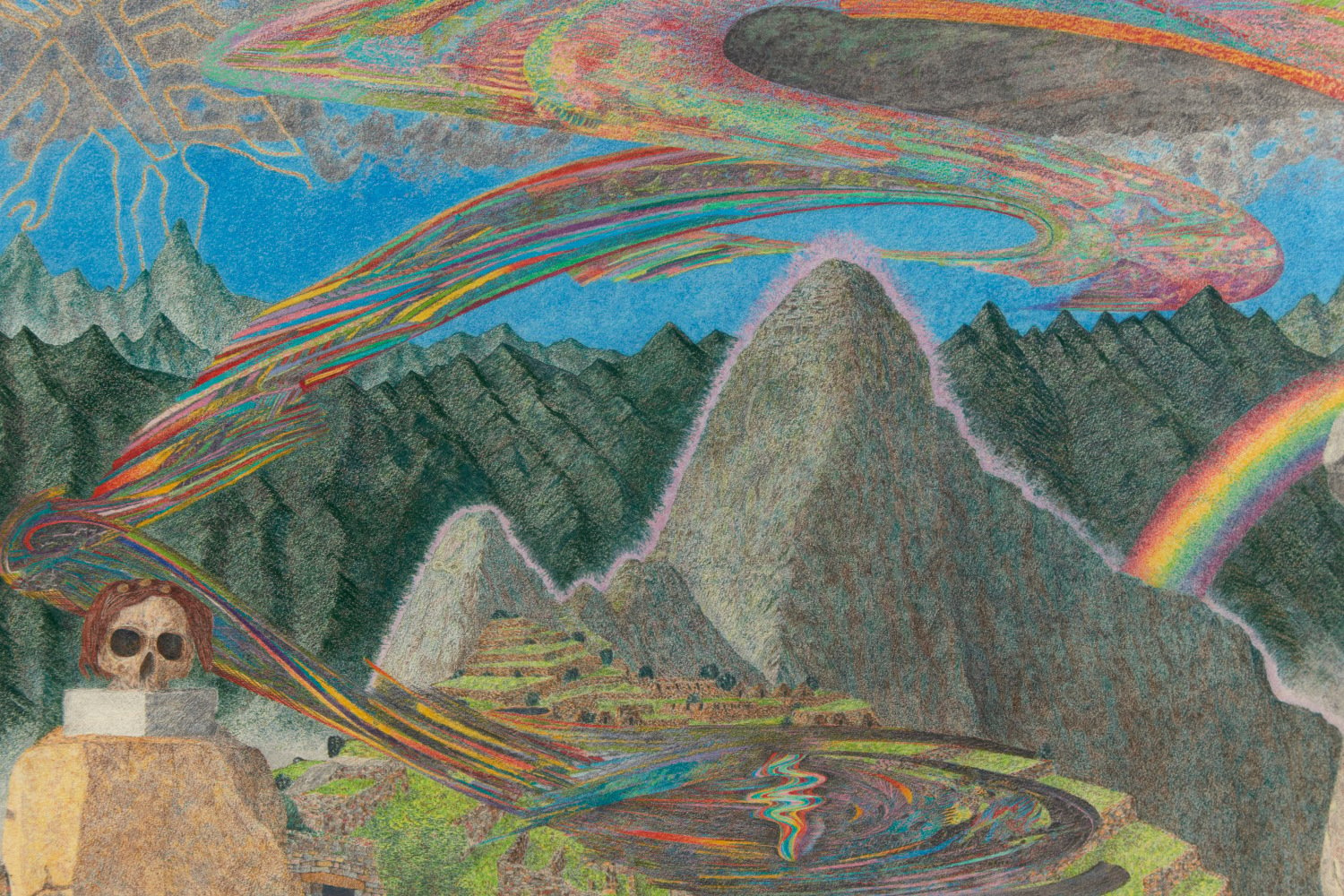
Many artists have interesting backstories, but few can hold to candle to the late Timothy Wyllie.
Wyllie, who passed away in 2017 at age 77, was a writer and an architect, a teacher and a telepath. He talked to dolphins, angels, and aliens, and co-founded a “spiritual community” most called a cult. Legend has it that he was the first person to give the Beatles acid.
He was also, it turns out, a prolific illustrator—and rarely seen examples of his work are on view this week at the Outsider Art Fair in New York, thanks to the curatorial project New Discretions.
Timothy Wyllie. Photo courtesy of June Atkin.
Your mileage may vary on the term “outsider art,” but it’s figures like Wyllie—an artist who willfully operated outside the confines of industry, not just one ghettoized by the capital-A art world—for which the designation makes sense.
Born in London, Wyllie trained to become an architect. After school, he became a member of the Process Church of the Final Judgment, a counter-cultural community that splintered off the Church of Scientology in the early 1960s and traveled across Europe and Canada before settling in the US.
A near-death experience in 1973 introduced Wyllie to the existence of angels, kickstarting a life-long exploration into rungs of reality beyond our own. Drugs aided him in his quest, and ketamine, in particular, was a favorite—it helped him channel his alternate-ego, an angelic being named Georgia. (If you know about Wyllie today, chances are it’s from his appearances on the Vice-produced docuseries, Hamilton’s Pharmacopeia, for which he recounted his experiences with PCP.)
Beginning in the ‘80s, Wyllie published numerous books on his experiences with drugs, mediation, and telepathic communication. It was around this time, too, that he turned to art.
Timothy Wyllie, A Relaxing Moment. Photo courtesy of New Discretions.
“Psychedelic” is an overused and often lazy adjective for describing art, but for Wyllie’s work, it’s accurate. With their nacreous whorls of color, hidden symbols, and occasional cameos from ETs, his illustrations look like those adorning dorm rooms or head shops—neat to look at sober, mind-melting to gaze at high.
But Dark Side of the Moon posters they are not. The artist’s drawings emerged from a lifelong exploration into extrasensory communication and were, for Wyllie, more functional than purely artistic. Most were created to illustrate phenomena described in his many published books, the titles of which include Dolphins, Telepathy, & Underwater Birthing and Revolt of the Rebel Angels.
It was right after the publication of another book, 2015’s The Helianx Proposition: The Return of the Rainbow Serpent―A Cosmic Creation Fable, that New Discretions founder Benjamin Tischer first discovered Wyllie’s art.
Timothy Wyllie, Angel of Piece: Glastonbury-Somerset (1998). Photo courtesy of New Discretions.
The two men had met years earlier through Genesis Breyer P-Orridge (she was a big fan of the Process Church and its magazine, which Wyllie helped design) and were catching up over lunch. Thumbing through The Helianx Proposition, Tischer was taken by a series of what he called “Tolkien-esque” illustrations throughout. (The comparison didn’t stop there: Wyllie, with his long white hair and beard, looked like a dead ringer for Gandalf, Tischer explained.)
“Oh, you did all these drawings?” Tisher recalled asking Wyllie at the time.
“‘Yes, yes, yes, but the drawings aren’t the important thing,” the artist responded. “‘The important thing is the theory behind it. My books are what’s good. The drawings are just something I do for fun.’”
Tischer was interested, but not hooked. As was perhaps the case for most people that met Wyllie, he wasn’t sure if the wizardlike figure was a visionary or a kook.
It wasn’t until 2021 that Tisher reentered Wyllie’s world. Around then, the dealer was contacted by June Atkin, an octogenarian artist living in Portland, Maine, who had taken control of Wyllie’s archive. (Longtime collaborators, Wyllie and Atkin referred to each other as “artners.”) She said that, prior to his passing, Wyllie had expressed an interest in showing his sketches, and invited Tischer to see them.
Eventually, Tischer made the trip with a curator friend. “We drove up and we were completely blown away,” he said, noting that the cache contained “300-plus highly realized drawings that ranged from super psychedelic hippie [scenes] to very realistic portrayals of saucers.”
What Tischer had missed in the books and the postage stamp-sized jpegs sent to him by Atkin was the overwhelming emotionality of Wyllie’s illustrations. “They are incredibly rich in person,” he explained. “He must have gone over these things again and again and again.”
Timothy Wyllie, A Visual Mantra for the Healing of Carolina. Photo courtesy of New Discretions.
Indeed, art may have been adjuvant to writing for Wyllie, but the former medium still proved to be a powerful form of expression. “He claimed that when he was ill that he could draw to heal,” Tischer said.
A handful of Wyllie’s spiritually inclined landscapes are on view at New Discretions’s booth in the fair. Prices range from $3,500 to $15,000, and many come in frames made by the artist himself (more than half of the profits will go toward Atkin, Tischer explained). The dealer is also working to organize more in-depth shows on the artist in the coming years.
“Timothy’s an unknown entity to the culture as a whole,” Tischer said. “That’s what’s so exciting about presenting it.”
The Outsider Art Fair is on view at the Metropolitan Pavilion, 134 10th Ave, New York, New York, March 2–March 5, 2023.